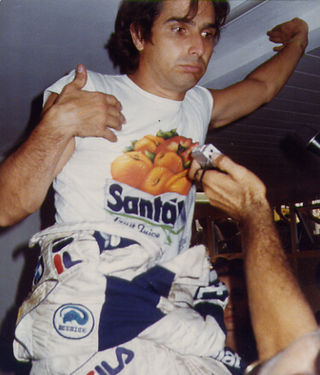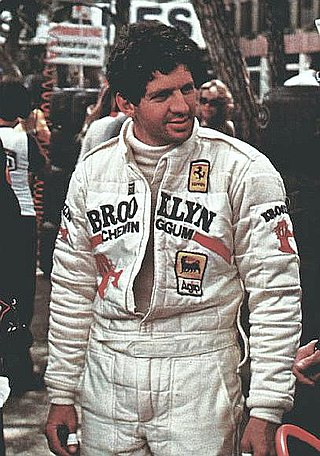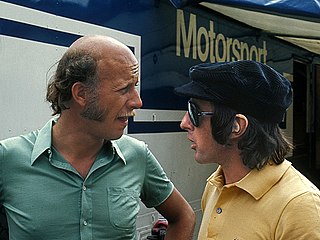Brabham is the common name for Motor Racing Developments Ltd., a British racing car manufacturer and Formula One racing team. Founded in 1960 by Australian driver Jack Brabham and British-Australian designer Ron Tauranac, the team won four Drivers' and two Constructors' World Championships in its 30-year Formula One history. Jack Brabham's 1966 FIA Drivers' Championship remains the only such achievement using a car bearing the driver's own name.

Renault, a French automobile manufacturer, has been associated with Formula One as both team owner and engine manufacturer for various periods since 1977. In 1977, the company entered Formula One as a constructor, introducing the turbo engine to Formula One with its EF1 engine. In 1983, Renault began supplying engines to other teams. Although the Renault team had won races, it withdrew at the end of 1985. Renault engines continued to be raced until 1986.

Formula One automobile racing has its roots in the European Grand Prix championships of the 1920s and 1930s, though the foundation of the modern Formula One began in 1946 with the Fédération Internationale de l'Automobile's (FIA) standardisation of rules, which was followed by a World Championship of Drivers in 1950.

The 1979 Italian Grand Prix was a Formula One motor race held on 9 September 1979 at Monza. It was the thirteenth race of the 1979 World Championship of F1 Drivers and the 1979 International Cup for F1 Constructors.

The 1981 FIA Formula One World Championship was the 35th season of FIA Formula One motor racing. It featured the 1981 Formula One World Championship for Drivers and the 1981 Formula One World Championship for Constructors, which were contested concurrently over a fifteen-race series that commenced on 15 March and ended on 17 October. Formula One cars also competed in the 1981 South African Grand Prix, although this was a Formula Libre race and was not part of the Formula One World Championship.

The 1979 Formula One season was the 33rd season of FIA Formula One motor racing. It featured the 1979 World Championship of F1 Drivers and the 1979 International Cup for F1 Constructors which were contested concurrently over a fifteen-round series which commenced on 21 January 1979, and ended on 7 October. The season also included three non-championship Formula One races. Jody Scheckter of Scuderia Ferrari won the 1979 World Championship of F1 Drivers while Scuderia Ferrari won 1979 International Cup for F1 Constructors. Gilles Villeneuve made it a 1–2 for Ferrari in the championship, concluding a successful second half of the 1970s for Ferrari. Alan Jones finished the season strongly for Williams, finishing third in the championship and with teammate Clay Regazzoni scoring Williams's first ever Grand Prix win as a constructor. Scheckter's title was Ferrari's last drivers' title for 21 years, before Michael Schumacher won five consecutive titles for the team between 2000 and 2004.

The 1973 Formula One season was the 27th season of FIA Formula One motor racing. It featured the 1973 World Championship of Drivers and the 1973 International Cup for F1 Manufacturers, which were contested concurrently over a fifteen-race series that commenced on 28 January and ended on 7 October. There were two new races for the 1973 season – the Brazilian Grand Prix at Interlagos in São Paulo and the Swedish Grand Prix at Anderstorp. The season also included two non-championship races which were open to both Formula One and Formula 5000 cars.

Hesketh Racing was a Formula One constructor from the United Kingdom, which competed from 1973 to 1978. The team competed in 52 World Championship Grands Prix, winning one and achieving eight further podium finishes. Its best placing in the World Constructors' Championship was fourth in 1975. Hesketh gave James Hunt his Formula One debut and he brought the team most of its success. Alan Jones also began his Formula One career in a privately entered Hesketh.
Ensign was a Formula One constructor from Britain. They participated in 133 grands prix, entering a total of 155 cars. Ensign scored 19 championship points and no podium finishes. The best result was a 4th place at the 1981 Brazilian Grand Prix by Marc Surer, who also took fastest lap of the race.
Merzario was a Formula One and Formula Two team and constructor from Italy. The team participated in 38 Formula One World Championship Grands Prix but scored no championship points.
Team Lotus was the motorsport sister company of English sports car manufacturer Lotus Cars. The team ran cars in many motorsport categories including Formula One, Formula Two, Formula Ford, Formula Junior, IndyCar, and sports car racing. More than ten years after its last race, Team Lotus remained one of the most successful racing teams of all time, winning seven Formula One Constructors' titles, six Drivers' Championships, and the Indianapolis 500 in the United States between 1962 and 1978. Under the direction of founder and chief designer Colin Chapman, Lotus was responsible for many innovative and experimental developments in critical motorsport, in both technical and commercial arenas.

Frank Williams Racing Cars was a British Formula One team and constructor.

The Lotus 49 was a Formula One racing car designed by Colin Chapman and Maurice Philippe for the 1967 F1 season. It was designed around the Cosworth DFV engine that would power most of the Formula One grid through the 1970s. It was one of the first F1 cars to use a stressed member engine combined with a monocoque to reduce weight, with other teams adopting the concept after its success. It also pioneered the use of aerofoils to generate downforce.

The Lotus 79 is a Formula One car designed in late 1977 by Colin Chapman, Geoff Aldridge, Martin Ogilvie, Tony Rudd, Tony Southgate and Peter Wright of Lotus. The Lotus 79 was the first F1 car to take full advantage of ground effects aerodynamics.

The McLaren M23 was a Formula One racing car designed by Gordon Coppuck, with input from John Barnard, and built by the McLaren team. It was a development of the McLaren M16 Indianapolis 500 car. A Ford Cosworth DFV engine was used, which was prepared by specialist tuning company Nicholson-McLaren Engines. This helped push the DFV's horsepower output to around 490 bhp.

The Brabham BT49 is a Formula One racing car designed by South African Gordon Murray for the British Brabham team. The BT49 competed in the 1979 to 1982 Formula One World Championships and was used by Brazilian driver Nelson Piquet to win his first World Championship in 1981.

Héctor Alonso Rebaque is a Mexican former racing driver who raced in Formula One and CART IndyCar in the 1970s and 1980s. He also ran for his own Formula One team called Rebaque in 1978 and 1979.

The Repco Brabham BT24 was a Formula One racing car design. It was one of three cars used by the Brabham racing team during their championship-winning 1967 Formula One season. Only three BT24 chassis were ever raced.

The March 701 is a Formula One racing car model, designed by Robin Herd with Peter Wright, and built by March Engineering. The 701 was March's first Formula One design – following their one-off March 693P Formula Three prototype of 1969 – and was designed and built in only three months. The March 701 made its race debut a month after its public unveiling, at the 1970 South African Grand Prix. In total, eleven 701s were constructed, with March supplying many privateer entrants as well as their own works team. The 701's career started well, March drivers taking three wins and three pole positions from the car's first four race entries, but lack of development through the 1970 Formula One season resulted in increasingly poor results as the year wore on. The 701 was superseded by the March 711 in 1971, and made its last World Championship race appearance at the 1971 Italian Grand Prix.















